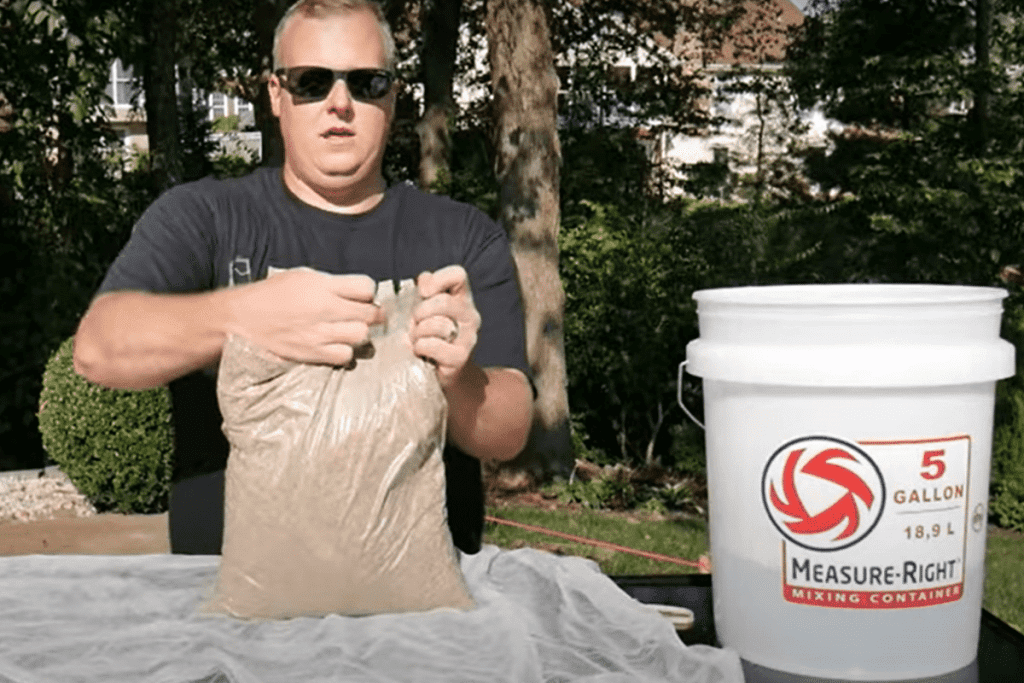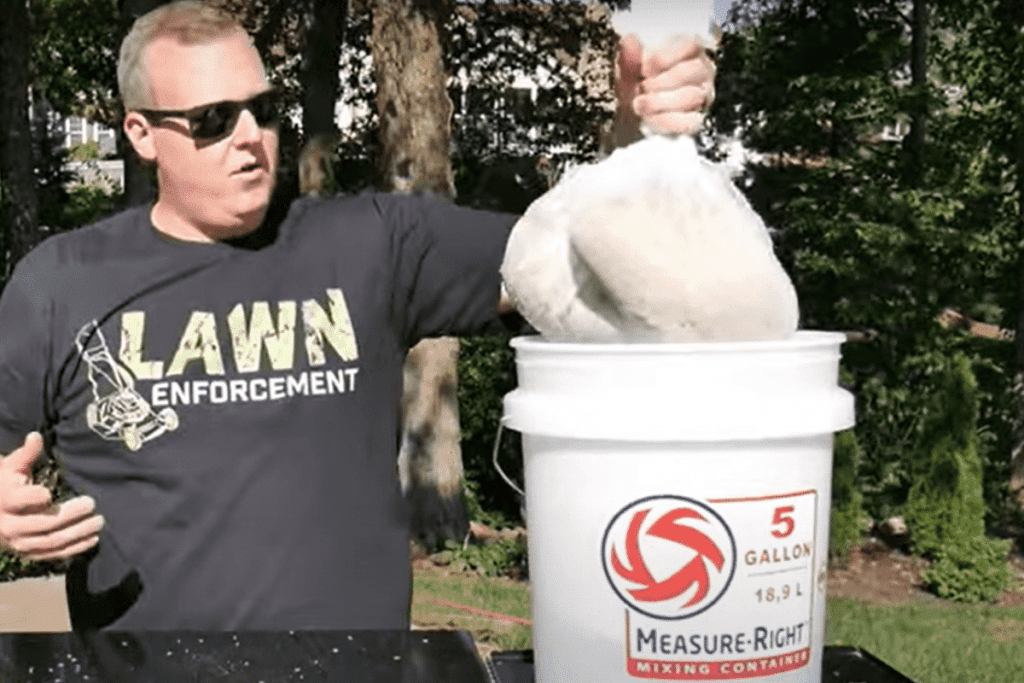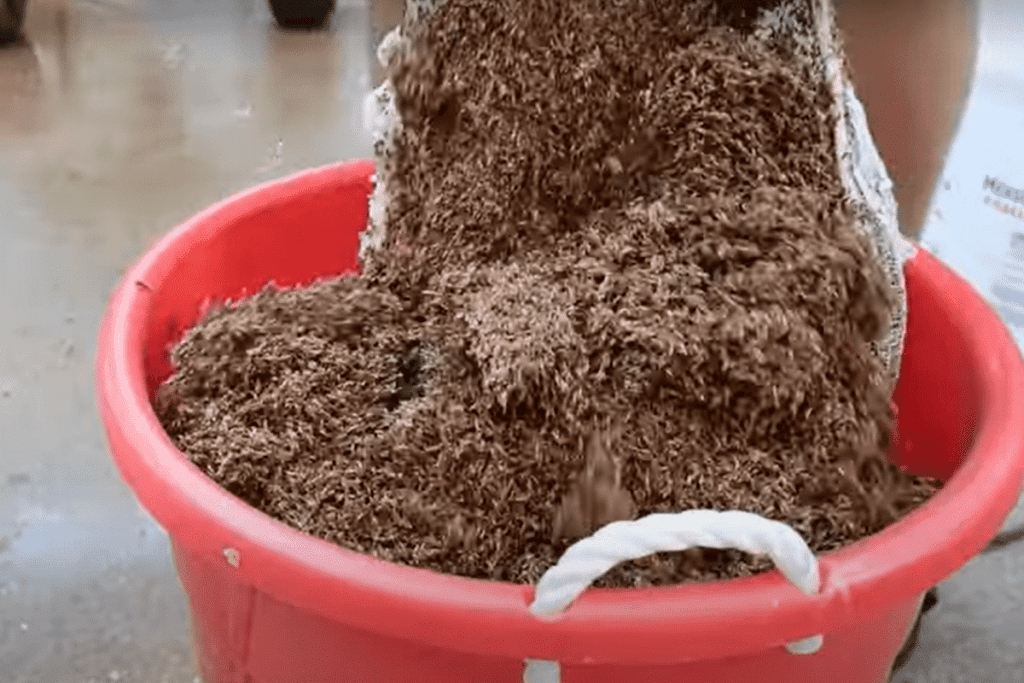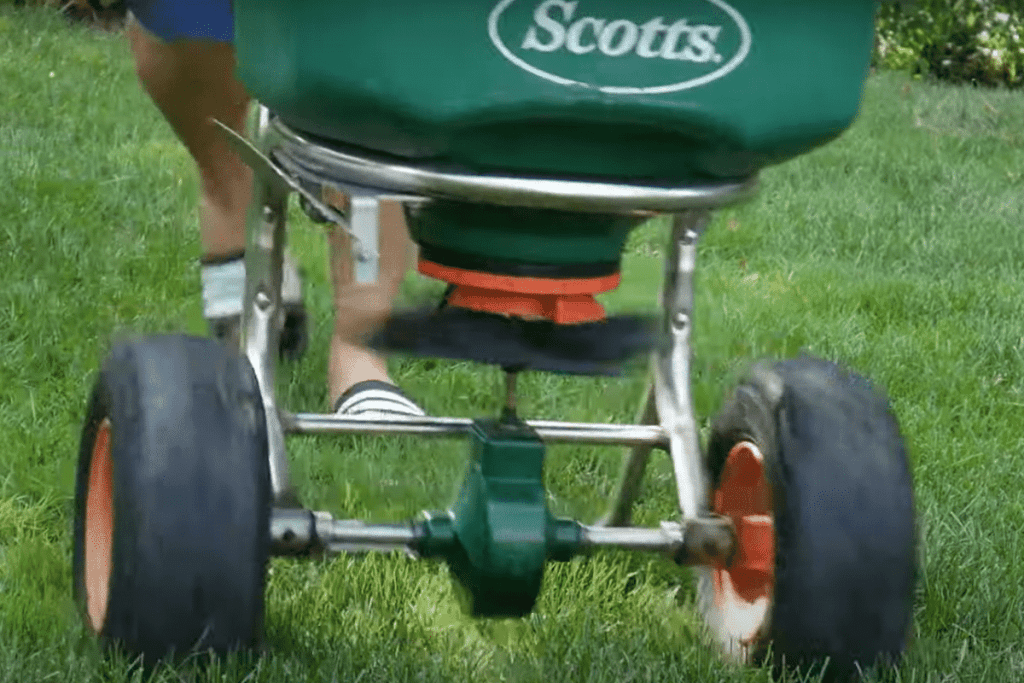Waiting for your grass seed to germinate in the ground takes a lot of patience and care.
No one likes to sit around and watch the grass grow.
Most of us also want to do as much as possible to ensure success as we plant new grass to achieve a lush lawn.
Sometimes, we don’t have the ideal conditions or time to wait for grass seed to germinate outside.
If you have kids or pets, keeping your family out of the yard for the 4-6 weeks it often takes for grass to establish itself might not be realistic.
If you need to fill in patches in your lawn or establish a new lawn, pre-germinating seed will yield quicker results for dense green grass.
We’ll walk you through everything you need and the steps to successfully pre-germinate grass seed for your lawn.

Table of Contents
Materials Needed
The materials needed for pre-germinating seed are most likely materials you already have in your garden shed, garage, or basement.
There isn’t any special equipment you’ll need.
Most homeowners who take care of their lawns already have most of these items on the list needed for pre-germination.
They are the same tools needed to lay new grass seed down.
There are a few things you may need to get to achieve seed germination success:
- Water
- Newspaper
- A large container like a garbage can, bucket, or fish tank
- Grass Seed
- Cheesecloth or other porous fabric
- Nitrogen-rich Fertilizer (Find on Amazon)
- Seed Spreader (Find On Amazon)
Before You Get Started
There are a few things you’ll want to take into consideration before you begin the process of pre-germinating grass seed for quicker lawn results.
Determine how much grass seed you need to pre-germinate by measuring the area you need to fill.
Grass seed packaging often details how much surface area it covers.
You’ll be able to determine how much grass seed you’ll need to germinate.
Check the weather and plan accordingly.
Germinated grass seeds with young shoots are very vulnerable to weather.
If there is a big storm coming, the seeds may wash away before they’ve had a chance to root.
Extreme temperatures will also put freshly germinated seeds at risk.
Extreme heat will burn and kill young grass seedlings, and extreme cold will freeze and kill young grass before it has a chance to grow strong and build resilience.
Measure Out And Prep Grass Seed

Once you’ve established how much grass seed needs to be pre-germinated, measure out the grass seed.
This is done by weight or volume, depending on the instructions of your particular grass seed product.
When you measure the grass seed, it must be wrapped in a porous fabric like cheesecloth.
Wrap the grass seed in the porous cloth and tie it off securely with a rubber band.
Using a porous fabric like cheesecloth allows water to fully soak into the grass seed without having all the seeds leak into the water.
Grass seeds are tiny, so you need to make sure whatever fabric you use is tightly knit enough to keep the seeds in.
You also need it to be slightly porous, so water successfully permeates and allows the seed to soak.
Soak Grass Seed In Water

Once the grass seed is wrapped up in a piece of cheesecloth or porous fabric, soak the grass seed in water.
Depending on how much grass seed you are pre-germinating, you may need a large container like a plastic garbage can or empty fish tank.
If you are filling in smaller patches, a bucket will likely suffice.
To successfully pre-germinate your grass seed, you need to fully submerge with water.
Once the container is filled with water, securely fasten the cover or lid.
Keep the container with your germinating grass seed in a warm place.
Temperature is an important factor for seed germination.
The ideal temperature for pre-germination is between 65 and 72° degrees Fahrenheit (22° C).
Maintain a warm temperature and keep the container covered to encourage healthy germination.
Usually, this takes 3-5 days for most popular grass seeds.
Some grass seed varieties require longer times than others.
For example, Kentucky Bluegrass usually takes 5 days to pre-germinate and be ready for planting.
Change Water Daily
Keeping the grass seed soaked with fresh water will set you up for successful pre-germination.
Change the water in your container or gallon bucket every 12 hours.
To do this, pull the wrapped grass seed out and dump the old water out.
Re-submerge the wrapped grass seed in clean water and keep it covered in a warm environment.
Most grass seeds take 3-5 days to germinate.
Leaving the grass seed in the water for too long will damage and kill the seeds, so timing is very important.
After three days, check the seeds for signs of germination.
Once most of the grass seeds have germinated, you’re ready to move on to the next steps.
Here are some signs of seed germination:
- Loosening of the hull of the grass seed
- Small white shoots coming out of the seed
Strain Pre-Germinated Grass Seed
Once your grass is germinating, it’s time to mix in fertilizer.
Make sure the majority of your grass seed has shown signs of germination.
You’ll see a high percentage of seeds with sprouted little white shoots from the shell.
To mix this with fertilizer, you’ll need to strain out all the water.
Pull the porous fabric containing the grass seed out of the water and container.
Allow the excess water to drip out of the wrapped sack with seed fully.
Once water is no longer dripping out of the wrapped seeds, it’s time to lay the grass seeds out on the soil.
Spread the pre-germinated grass seed onto newspaper, clean sheets, or another smooth surface.
Keep the grass seed laid out to dry it out slightly.
You don’t want to overly dry out the grass seed, but you want dry seed, so it is easy to handle and effectively mix with the fertilizer.
Mix Pre-Germinated Grass Seed With Fertilizer

Using a nitrogen-rich fertilizer will help set the grass seed up for successful and healthy growth.
Growing seeds and young grass shoots need extra nutrients to grow well.
Nitrogen is very beneficial for new grass and will help the seeds grow well.
It also makes it much easier to spread the mixture on the ground.
Place the fertilizer in a bucket and mix in the grass seed.
Gently mix the grass seeds into the fertilizer with your hands to avoid seed damage.
Using your hands keeps the grass seeds from getting crushed or damaged.
Spread Pre-Germinated Seeds

Once the fertilizer and grass seed mixture is thoroughly and evenly mixed, you’ll want to let it dry out slightly.
You’ll want it to still be moist but not clumpy.
It is difficult to distribute excessively wet fertilizer and wet seeds as they stick together and don’t spread evenly.
The best way to evenly distribute pre-germinated grass seed with the fertilizer is to get a lush and green lawn with a seed spreader.
This ensures the mixture of seed and fertilizer doesn’t leave large piles and skip other areas.
This will result in bald spots and will require further work and extra seed to fill out.
Video Instructions And Timestamps
Watch this video to see each step of the pre-germination process carried out.
Following these directions and the video help set you up for success in your endeavor to pre-germinate grass seed for quicker lawn results.
- Measure out and prep grass seed 2:10
- Soak grass seed in water 3:20
- Change water daily 3:24
- Mix seed with fertilizer 4:40
- Spread pre-germinated seedlings 5:25
Benefits Of Pre-Germination
Pre-germination allows grass to be planted earlier and later in the season than regular grass seed normally allows.
Grass seed is very susceptible to harm from extreme temperatures, especially frost.
In many places, frost happens both in the late fall and early spring.
Pre-germinating allows grass seed to grow in ideal conditions before putting it in the ground.
Seeds are very attractive to wildlife like birds, squirrels, and chipmunks.
Once the seeds germinate, they stand a better chance of not getting snatched up and eaten by wildlife.
It cuts down on the time needed to successfully establish a new lawn.
Certain grass varieties like Bentgrass and Bluegrass seed take a long time to germinate.
Pre-germinating them before you plant cuts down on time needed for the grass to establish itself.
No one likes the waiting game of sitting around and watching the grass grow.
Pre-germinating grass seed yields quicker results by cutting down on seed germination time.
You don’t have to wait for the ideal soil temperature or perfect air temperature to plant the seed in the soil.
Live in the midwest? Learn the best time to plant grass in Michigan and the midwest.
Tips To Successfully Pre-Germinate Grass Seeds
If you follow the instructions for your specific type of grass seed and our guide, you should have no trouble speeding up germination times.
There are still some tips and tricks to consider to ensure success with the germination of grass seed.
Don’t Let Frost Kill Your Grass Seed
Many people choose to pre-germinate their grass seeds because they are planting during the early fall or late spring.
During these times of the season, there is a higher chance of frost coming.
Frost kills grass seeds and young grass shoots alike.
While pre-germinated seed allows you to give your grass seed a head start, the young shoots are still vulnerable to frost.
Make sure there is frost in the forecast for at least a week after planting your grass seed.
You may be able to keep your grass seed safe by covering it if an unexpected frost comes after you’ve already laid the seed outside in the soil.
Rake Grass Seed After Spreading
Using a rake to gently push the grass seed in the ground helps it grow quickly and healthily.
Different types of grass require different soil depths for optimal growth.
Grass seed requires soil contact to get the nutrients it needs.
It also needs sufficient contact with the soil to establish roots effectively.
Ensure to consult the specific needs of your specific grass variety to keep conditions ideal for your young grass plants.
Most sandy soil requires watering to distribute seeds.
Keep Grass Seed Well Irrigated
Growing grass seed needs to be well watered. Keep the soil moist but not soaked.
Overwatered grass seed may get washed away and lead to patchy growth.
If the grass seedlings get too dried out, they will not grow and may get burned by excessive sunlight or heat.
Most grass varieties require about an inch of the topsoil to be thoroughly watered.
Common Mistakes To Avoid
For first-timers, pre-germination seems a bit daunting or out of your wheelhouse.
Luckily, it is fairly simple so long as you follow your grass variety’s instructions and specific needs.
We’ll also help you to avoid common mistakes made by beginners.
Not Changing Water Often
Some people find mixing the seeds and water daily enough to encourage proper germination in the containers.
However, we recommend changing the water to make sure the water stays clean.
There is a chance of bacteria or fungus forming in the water if it doesn’t stay clean.
Changing the water out keeps the water clean and free of harmful bacteria forming.
It also allows the seeds to mix and move in the water to sufficiently absorb and germinate.
Soaking The Grass Seed For Longer Than Needed
Sometimes people keep the grass seed in the water for longer than necessary.
While it is advantageous to germinate most seeds, waiting too long may damage the grass seed.
Over soaking the seeds may seem like a good idea to get more white shoots, but it ultimately tends to do more harm than good.
Even if you don’t see the obvious signs of germination in all the seeds, they still are ahead of the game.
They will likely fully germinate and shoot out seedlings much quicker than if they hadn’t been soaked.
Spreading Grass Seed During Less Than Ideal Conditions
Even if you set your grass seed up for success with pre-germination, you still need to consider the elements and conditions.
Planting your new grass seedlings in extreme temperatures or adverse conditions will undo all the hard work you put into pre-germinating the seeds.
It’s also important to ensure there will not be excessively heavy traffic over the areas where you plant the seedlings.
They are still young and susceptible to damage.
While the growing time is drastically cut down with pre-germination, they still need to be protected while establishing their roots and gaining strength.